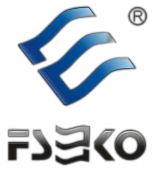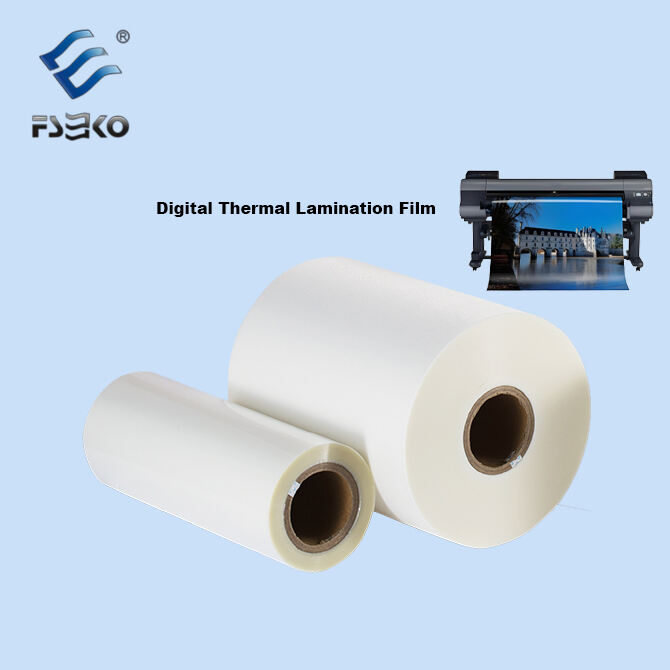Защита на инвестициите в печат чрез цифрова ламинационна фолия
Бариеерни свойства и експлоатационни предимства на цифровата ламинационна фолия
Ламинационните филми осигуряват няколко слоя защита за отпечатани материали, предлагайки както химическа устойчивост, така и добра физическа якост. Вариантите с устойчивост към UV лъчите могат да блокират около 99 процента от вредното слънце, което означава, че графичните елементи остават значително по-дълго на открито – понякога от около шест месеца до цели четири години, според изследване на Innotech Digital от 2024 г. Тези филми също притежават специални бариери, които задържат влагата с впечатляваща скорост от само 0,03 грама на квадратен метър на ден. Това допринася значително за предотвратяване на проблеми като деформация или размазване на мастилото, когато се прилагат върху материали като обикновена хартия, която лесно абсорбира вода.
Влияние върху продължителността на живот на отпечатъците и защита срещу драскотини, UV лъчи и влага
Според изследване на Electronic Office Systems (2024) при тестване по ASTM D5264, ламинираните отпечатъци издържат около десет пъти повече износване в сравнение с обикновените отпечатъци без защита. Това означава, че магазините в натоварени зони имат приблизително с 63 процента по-малко нужда от препечатване на знаците си всяка година. Материалът има клас на твърдост с молив 5H, което надминава стандартните лакове с клас само 2H, като по този начин е значително по-добър в устойчивостта срещу драскотини. Освен това включва добавки против замъгляване, така че отпечатъкът остава ясен дори на места, където се натрупва влага, например в кухни на ресторанти, където постоянно присъства пара.
Кейс Стъди: Удължена издръжливост на ламинирани менюта в ресторанти с голямо натоварване
Ресторантите тестваха ламинирани менюта от PETG филм в продължение на цели 12 месеца в повече от 30 обекта и повечето запазиха цветовете си пресни около 92% от времето, като същевременно запазиха приятното усещане, което клиентите очакват. Менютата без ламинация? Те трябваше да се подменят приблизително всеки три месеца, защото просто поемаха мазните отпечатъци от пръсти и получаваха онези досадни изтръгнати ръбове. Собствениците на ресторанти ни казаха, че разходите им за менюта за година намалели с около 40%, което се увеличава при умножаване по множество обекти. Освен това персоналът прекарвал около 18 по-малко часа на месец в почистване на менюта, тъй като плисканията се бършеха много по-лесно от тези специални повърхности. Всъщност е логично – кой иска цял ден да се занимава с лепкави мръсотии по хартия?
Изгодност и дългосрочна икономия при цифровата ламинация
Намаляване на разходите за преотпечатване чрез подобрена издръжливост на отпечатъците
Цифровото ламиниране създава защитен слой, който пази отпечатаните материали и ги прави значително по-дълготрайни. Вместо само 6 до 8 месеца, отпечатъците могат да запазят добрия си вид около 3 до 4 години според Доклада за трайност на печата от 2023 г. Това всъщност намалява честотата на подмяната на материалите почти 8 пъти от всеки 10 случая. Собствениците на ресторанти знаят това много добре, защото менютата им се докосват непрекъснато през целия ден. Същото важи и за ярките постери на събития, които всеки докосва. Наскорошно проучване в хората индустрия показа нещо доста впечатляващо. Ресторантите, преминали към ламинирани менюта, спестяват около 1200 долара годишно на всяко място, просто защото петната от храна и общото износване вече не ги повреждат толкова бързо.
Голямо количество употреба и икономическа ефективност за операции с висок обем печат
Операциите с висок обем постигат икономия на разходи от 18–30% чрез групови покупки на филми и оптимизирани работни процеси. Цифровите системи за ламиниране могат да обработват над 400 листа в час, без да компрометират адхезията, което ги прави идеални за каталози, прототипи на опаковки и табели за дребно търговско предлагане. Тези ефективности водят до 22% по-бързо време за изпълнение благодарение на намалените отпадъци и по-малко интервенции от оператора.
Оценка на цената на ролка спрямо дългосрочната стойност
| Фaktор | Себестойност в краткосрочен план | Дългосрочни спестявания |
|---|---|---|
| Филм/Ролка | $85–$120 | — |
| Предотвратяване на повторно печатане | — | $240–$600/годишно |
| Ефективност на труда | — | 15–25 часа/годишно |
Въпреки че преоценените филми имат 10–15% по-висока първоначална цена на ролка, покритията им, устойчиви на драскотини, и UV инхибитори осигуряват трикратен ROI в рамките на пет години. За принтери, насочени към стойността през целия жизнен цикъл, това превръща цифровото ламиниране в стратегическа инвестиция.
Подобряване на естетиката и възприеманата стойност с финишни покрития чрез ламиниране
Гланцови, матови, меки на допир и холографски финишни покрития, използвайки цифров ламиниращ филм
Когато става въпрос за филми за цифрово ламиниране, има основно четири основни вида отделка, които наистина могат да отличат печатните материали. Гланцова отделка прави цветовете значително по-ярки — според проучване на Lamination Station от миналата година, с около 22% по-интензивни. Затова често я срещаме в продуктови брошури и в онези привличащи вниманието маркетингови летаци. Следва матовата версия, която намалява досадните отражения, без да засяга яснотата на изображенията. Архитектите предпочитат тази за презентационните си табла, а ресторантите често я избират и за меню карти. Филмите с „меко усещане“ станаха доста популярни напоследък, защото усещането при докосване е много приятно, почти като кадифе. Според данни на BrillPack от началото на тази година, някои изследвания показват, че хората взаимодействат с такива материали около 38% повече в сравнение с обикновените. И нека не забравяме и холограмните ефекти. Те създават онези интересни променящи се модели при различни условия на осветление, което е изключително ефективно на конгреси и изложбени стендове, където привличането на вниманието е от съществено значение.
Подобряване на тактилното качество и визуалната яснота за повишаване на възприятието на клиента
Повърхностната обработка директно влияе на възприеманата качество: 72% от потребителите асоциират ламиниране с меко усещане с премиум брандиране (Lamination Station 2023). Филмът подобрява дефиницията на мастилото и прикрива недостатъците на основата, което допринася за по-професионален вид. Една електронна марка отбеляза 27% увеличение в удовлетвореността на клиентите след преминаването към ламинирана опаковка, като сочи подобрена издръжливост по време на транспортиране.
Как ламинацията увеличава възприеманата стойност на продукта в маркетинговите материали
Брошури и визитки, които са с ламинирано покритие, обикновено се запазват около 59% по-дълго в сравнение с тези без ламинация. Проучване от 2024 г. показва, че хората възприемат ламинираните материали като професионални приблизително 3,2 пъти по-често в сравнение с обикновената хартия. Висококачествените козметични компании добре познават този трик — те комбинират матови филми с релефни логота, за да предложат на клиентите нещо усещано тактилно и визуално привлекателно едновременно. Според данни на BrillPack от миналата година, подобни сензорни елементи могат да повишат възприеманата от потребителите стойност на продуктите с около 41%. Такова предимство има голямо значение в индустрии, където мнението при първия поглед често определя дали клиентът ще купи или ще си тръгне.
Безпроблемна интеграция в цифрови печатни потоци
Съвместимост с цифрови принтери и често използвани материали (хартия, синтетични основи)
Съвременните цифрови ламинационни филми се интегрират гладко с ултравиолетово отверждаващи, латексови и тонерни цифрови принтери, като минимизират настройките при смяната на поръчките. Според Доклада за печатни технологии 2024 повече от 89% от операторите успешно прилагат тези филми върху широк спектър от материали, включително дебели хартиени основи (до 400 gsm), полиетилен и текстурни повърхности.
Адхезивни характеристики и надеждност върху покрити и непокрити материали
Изследвания на якост при отлепване показват, че ламинираните отпечатъци запазват 98% адхезивна цялост след над 1000 цикъла на огъване върху непокрити основи – с 17% по-добре в сравнение с традиционните филми (PrintQuality Labs 2023). УВ-стабилни адхезиви предотвратяват разслояване върху покрити материали дори при продължително въздействие на слънчева светлина, което подобрява надеждността за улични табели и дисплеи в търговски обекти.
Вградено срещу отделно ламиниране: Ефективност в комерсиални производствени среди
Системите за вградено ламиниране намаляват времето за обработка с 22% в сравнение с извънлайн методите при среди с голям обем. Докато извънлайн единиците позволяват по-голяма гъвкавост за специални повърхности, интегрираните вградени работни процеси отчитат 17% по-малко дефекти и 31% по-бързо завършване на поръчки — ключови предимства за обекти, обработващи над 50 000 отпечатъка месечно.
Бъдещи тенденции и устойчиви иновации в областта на филмите за цифрово ламиниране
По-тънки, по-силни и екологични филмови технологии в хоризонта
Технологията за цифрово ламиниране напредва бързо през последните дни, предлагайки по-добра производителност, без да навреди толкова на околната среда. Според скорошно проучване на пазара от 2024 година, около две трети от хората, които купуват печатни материали, искат биоразградими или нещо, което могат да рециклират до следващата година, предимно поради все по-строгите правила на Европейския съюз относно отпадъците от опаковки. Благодарение на постиженията в нанотехнологиите, виждаме филми, които всъщност са около една трета по-тънки от преди, но все още устояват на разкъсване и драскотини. Тези подобрения бяха тествани задълбочено чрез процеси за сертифициране по ISO 9001 в множество обекти по света.
Растяща търсеност на биоразградими и рециклируеми опции за ламиниране
Движението за устойчивост променя начина, по който се избират материали днес, като компостируемите ламинати стават все по-популярни сред производителите. Според доклада на PIRA International от 2023 г., около 18 процента от всички нови продукти, появяващи се на пазара, вече използват водно разтворими адхезиви или монофилми, които всъщност могат напълно да се рециклират. Тези видове иновации имат значение, защото помагат на компаниите да отговарят на екологичните стандарти, които все повече клиенти изискват днес. Безразтворни системи за ламинация също започват да се срещат по-често в индустрии като опаковане на храни и медицинско печатане. Те намаляват емисиите на летливи органични съединения с около 95% в сравнение с традиционните разтворни методи. Докато екологичните сертификати стават стандартно изискване в процесите на доставки, бизнесите все повече се насочват към тези по-чисти производствени опции, независимо дали искат или не.
Производителите постигат икономическа ефективност заедно с иновации: 78% от преобразуващите компании съобщават, че по-тънките филми намаляват разходите за материали, без да жертват защитата, според проучване на FTA от 2023 г.
Часто задавани въпроси
Какви са основните предимства при използването на цифров ламиниращ филм?
Цифровият ламиниращ филм осигурява защита срещу UV лъчи, влага и драскотини, удължава живота на печатните материали и добавя естетическа привлекателност с финишни варианти като гланц, матов, меко усещане и холографски.
Как влияе цифровото ламиниране върху издръжливостта на печата?
Ламинираните печати издръжват значително по-дълго, често увеличавайки своя живот от 6-8 месеца до 3-4 години, което намалява нуждата от чести повторни отпечатъци.
Нали ли са биоразградими и екологични опции за ламиниране?
Да, има растящ търсене на биоразградими и рециклируеми ламинати, като нововъведения като водно базирани лепила и моно материални филми стават все по-популярни.
Какви икономии могат да очакват бизнесите чрез използването на цифрово ламиниране?
Бизнесите могат да постигнат икономия на разходи между 18% и 30% чрез групови покупки и процесни ефективности, както и допълнителна икономия от намалената нужда от повторно печатане и трудови часове.
Съдържание
- Защита на инвестициите в печат чрез цифрова ламинационна фолия
- Изгодност и дългосрочна икономия при цифровата ламинация
- Подобряване на естетиката и възприеманата стойност с финишни покрития чрез ламиниране
- Безпроблемна интеграция в цифрови печатни потоци
- Бъдещи тенденции и устойчиви иновации в областта на филмите за цифрово ламиниране
- Часто задавани въпроси


